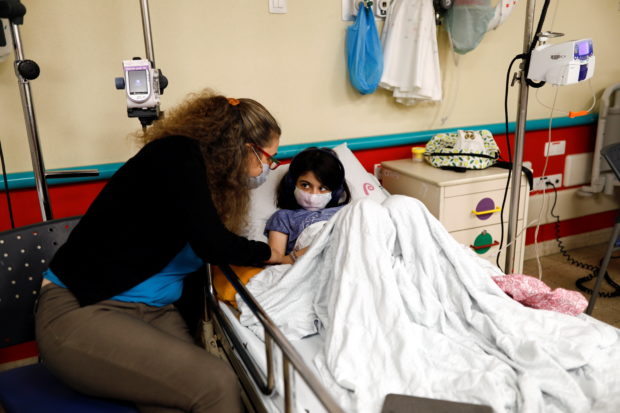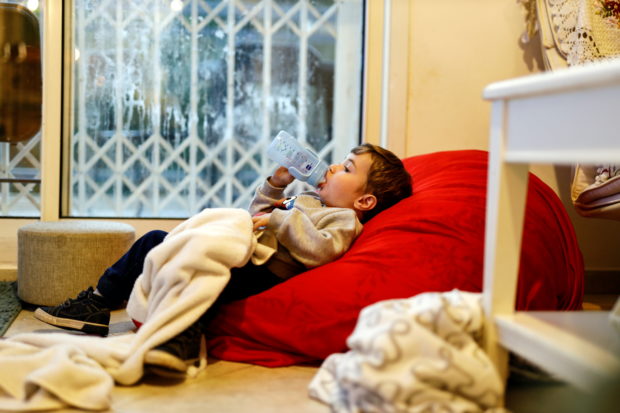Doctors weigh COVID-19 impact on children as vaccine drives ramp up

Noa, a 10-year-old Israeli girl suffering from Long COVID, chats with her mother in a post-coronavirus disease (COVID-19) clinic in Schneider Children’s Medical Center, in Petah Tikva, Israel December 6, 2021. REUTERS/Corinna Kern
JERUSALEM — One month after her son Eran had recovered from a mild case of COVID-19, Sara Bittan rushed the three-year-old to the emergency room. He had a high fever, a rash, his eyes and lower body were swollen and red, his stomach was hurting, and he was crying in pain.
Eventually diagnosed with the rare multisystem inflammatory syndrome in children (MIS-C), also known as a pediatric inflammatory multisystem syndrome or PIMS, Eran was hospitalized in October for a week and has fully recovered, Bittan said.
“It is important for me to tell parents, mothers, all over the world that there is a risk. They should know,” said Bittan. “He suffered a lot and I suffered with him.”
Two years into the COVID-19 pandemic, doctors worldwide are learning more about how the illness impacts children.
While cases of severe illness and death remain far rarer among pediatric patients than adults, tens of thousands of children may struggle with its effects. The U.S. Centers for Disease Control and Prevention (CDC) cites COVID-19 as one of the top-10 causes of death among children aged 5 to 11.
Article continues after this advertisementA very small portion can suffer badly from complications, such as PIMS, which affects fewer than 0.1% of infected children. “Long COVID” – the persistence of symptoms weeks or months after infection –affects children as well as adults.
Article continues after this advertisementA growing number of countries are making COVID-19 vaccines eligible for younger children. The European Union will begin a campaign to inoculate 5- to 11-year-olds next week, while a similar U.S. vaccination drive that began in November appears to be losing momentum.
Doctors hope the knowledge they have gained will not only improve treatment but also help parents understand the risks of COVID-19 as they consider vaccinating their children.
“Long COVID and PIMS are a major consideration in getting vaccinated,” said Liat Ashkenazi-Hoffnung, who heads the post-coronavirus clinic at Schneider Children’s Medical Center of Israel.
PIMS, which typically occurs a few weeks after coronavirus infection, is caused by the immune system suddenly going into overdrive, creating inflammation in the heart, lungs, kidneys, brain, and gastrointestinal organs. Affected children may spend up to two weeks in hospital, some requiring intensive care.
The CDC cited close to 6,000 PIMS cases nationwide, including 52 deaths. It is roughly estimated at 3 cases per 10,000 children, according to Boston Children’s Hospital’s Audrey Dionne, about in line with some European statistics and with the Israeli estimate of one in every 3,500 children infected and a fatality rate of 1%-2%.
Singapore’s Ministry of Health cites six cases of PIMS among more than 8,000 pediatric COVID-19 cases.
‘Very disheartened’
Doctors said they have learned how to better treat the condition with most children recovering. UK studies of children six months and one year after PIMS show that most problems had been resolved.
“Children from the second wave and now from the third wave (of COVID-19) are benefiting from the information of the first wave,” said Karyn Moshal, a pediatric infectious diseases expert at London’s Great Ormond Street Hospital.

Eran, a 3-year-old Israeli boy who suffered from PIMS, a rare consequence of the coronavirus disease (COVID-19), drinks from a bottle in his family home, in Tzur Hadassah, Israel December 5, 2021. REUTERS/Corinna Kern
A six-month assessment by Moshal and colleagues published in The Lancet found organ damage to be uncommon in children who were hospitalized with PIMS. Lingering symptoms including mental fatigue and physical weakness often persisted but resolved with time.
“They get tired more quickly. So schoolwork is affected because they can only concentrate for a shorter period of time,” Moshal said. “Understanding this is important both for the families and for the young people because they can get very disheartened, and also for schools and teachers to understand how to deal with it.”
Several UK and U.S. studies have found that PIMS is more likely to affect Black, Hispanic, and Asian children, although the reasons for that are still unknown.
Identifying long COVID in children presents more of a challenge. Determining its prevalence depends on what symptoms are looked at, and from whom the information is collected – physicians, parents or the children themselves, said Ashkenazi-Hoffnung.
Cautious estimates find about 1% of children with coronavirus will suffer long COVID, said Zachi Grossman, chairman of the Israel Pediatric Association.
Ashkenazi-Hoffnung said her clinic has treated around 200 children for long COVID.
She believes that is likely only the “tip of the iceberg” among previously healthy children and teens, who months after being infected suffer symptoms such as shortness of breath, fatigue, chest pain, headaches, tremors, and dizziness.
“It can dramatically affect the quality of life,” she said.
Simple actions like climbing stairs, running for a bus, or simply standing or walking are intolerable, Ashkenazi-Hoffnung said. Some children have developed asthma-like symptoms or hearing loss, and some toddlers who had been walking reverted to crawling because they were so tired and achy.
Most children do recover with time, she said, aided by physiotherapy and medication. Around 20% are still struggling.
Ashkenazi-Hoffnung and Moshal noted an extra burden observed in children who suffered PIMS or long COVID – a sense of stigma and shame.
“I was quite shocked by this,” said Moshal. “You can’t ascribe blame or shame for being infected with a disease.”
For more news about the novel coronavirus click here.
What you need to know about Coronavirus.
For more information on COVID-19, call the DOH Hotline: (02) 86517800 local 1149/1150.
The Inquirer Foundation supports our healthcare frontliners and is still accepting cash donations to be deposited at Banco de Oro (BDO) current account #007960018860 or donate through PayMaya using this link.